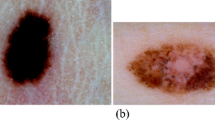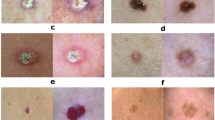Abstract
Every year, the number of skin cancer cases has been increasing which, consequently, increases the strain on the health care systems around the globe. With the growth of processing power and camera quality on smartphones, the investment in telemedicine and the development of mobile teledermatology applications can, not only contribute to the standardization of image acquisitions but also, facilitate early diagnosis. This paper presents a new process for real-time automated image acquisition of macroscopic skin images with the merging of an automated focus assessment feature-based machine learning algorithm with conventional computer vision techniques to segment dermatological images. Three datasets were used to develop and evaluate the proposed methodology. One comprised of 3428 images acquired with a mobile phone for this purpose and 1380 from the other two datasets which are publicly available. The best focus assessment model achieved an accuracy of 88.3% and an F1-Score of 86.8%. The segmentation algorithm obtained a Jaccard index of 85.81% for the SMARTSKINS dataset and 68.59% for the Dermofit dataset. The algorithms were deployed to a mobile application, available in Android and iOS, without causing any performance hindrances. The application was tested in a real environment, being used in a 10-month pilot study with six General and Family Medicine doctors and one Dermatologist. The easiness to acquire dermatological images, image quality, and standardization were referred to as the main advantages of the application.
Access this chapter
Tax calculation will be finalised at checkout
Purchases are for personal use only
Similar content being viewed by others
References
Alves, J., Moreira, D., Alves, P., Rosado, L., Vasconcelos, M.: Automatic focus assessment on dermoscopic images acquired with smartphones. Sensors (Switzerland) 19(22), 4957 (2019). https://doi.org/10.3390/s19224957
Andrade, C., Teixeira, L.F., Vasconcelos, M.J.M., Rosado, L.: Deep learning models for segmentation of mobile-acquired dermatological images. In: Campilho, A., Karray, F., Wang, Z. (eds.) ICIAR 2020. LNCS, vol. 12132, pp. 228–237. Springer, Cham (2020). https://doi.org/10.1007/978-3-030-50516-5_20
Apalla, Z., Nashan, D., Weller, R.B., Castellsagué, X.: Skin cancer: epidemiology, disease burden, pathophysiology, diagnosis, and therapeutic approaches. Dermatol. Ther. 7(1), 5–19 (2017)
Bangor, A., Kortum, P., Miller, J.: Determining what individual SUS scores mean: adding an adjective rating scale. J. Usability Stud. 4(3), 114–123 (2009)
Brooke, J.: SUS: a retrospective. J. Usability Stud. 8(2), 29–40 (2013)
Börve, A., et al.: Smartphone teledermoscopy referrals: a novel process for improved triage of skin cancer patients. Acta Dermato-Venereologica 95 (2014). https://doi.org/10.2340/00015555-1906
Carvalho, R., Morgado, A.C., Andrade, C., Nedelcu, T., Carreiro, A., Vasconcelos, M.J.M.: Integrating domain knowledge into deep learning for skin lesion risk prioritization to assist teledermatology referral. Diagnostics 12(1) (2022). https://doi.org/10.3390/diagnostics12010036
de Carvalho, T.M., Noels, E., Wakkee, M., Udrea, A., Nijsten, T.: Development of smartphone apps for skin cancer risk assessment: progress and promise. JMIR Dermatol. 2(1), e13376 (2019)
Commissioning PC: Quality standards for teledermatology using ‘store and forward’ images (2011). https://sad.org.ar/wp-content/uploads/2020/12/Teledermatology-Quality-Standards.pdf. Accessed 15 Nov 2022
Dahlén Gyllencreutz, J., Johansson Backman, E., Terstappen, K., Paoli, J.: Teledermoscopy images acquired in primary health care and hospital settings - a comparative study of image quality. J. Eur. Acad. Dermatol. Venereol. 32(6), 1038–1043 (2018). https://doi.org/10.1111/jdv.14565
Dugonik, B., Dugonik, A., Marovt, M., Golob, M.: Image quality assessment of digital image capturing devices for melanoma detection. Appl. Sci. (Switzerland) 10(8), 2876 (2020). https://doi.org/10.3390/APP10082876
Errichetti, E., Stinco, G.: Dermoscopy in general dermatology: a practical overview. Dermatol. Ther. 6(4), 471–507 (2016)
Faria, J., Almeida, J., Vasconcelos, M.J.M., Rosado, L.: Automated mobile image acquisition of skin wounds using real-time deep neural networks. In: Zheng, Y., Williams, B.M., Chen, K. (eds.) MIUA 2019. CCIS, vol. 1065, pp. 61–73. Springer, Cham (2020). https://doi.org/10.1007/978-3-030-39343-4_6
Ferlay, J., et al.: Estimating the global cancer incidence and mortality in 2018: GLOBOCAN sources and methods. Int. J. Cancer 144(8), 1941–1953 (2019)
Fernandes, K., Cruz, R., Cardoso, J.S.: Deep image segmentation by quality inference. In: 2018 International Joint Conference on Neural Networks (IJCNN), pp. 1–8. IEEE (2018)
Feurer, M., Klein, A., Eggensperger, K., Springenberg, J., Blum, M., Hutter, F.: Efficient and robust automated machine learning. In: Advances in Neural Information Processing Systems, pp. 2962–2970 (2015)
Finnane, A., et al.: Proposed technical guidelines for the acquisition of clinical images of skin-related conditions. JAMA Dermatol. 153(5), 453–457 (2017). https://doi.org/10.1001/jamadermatol.2016.6214
Finnane, A., Dallest, K., Janda, M., Soyer, H.P.: Teledermatology for the diagnosis and management of skin cancer: a systematic review. JAMA Dermatol. 153(3), 319–327 (2017)
Flores, E., Scharcanski, J.: Segmentation of melanocytic skin lesions using feature learning and dictionaries. Expert Syst. Appl. 56, 300–309 (2016)
Gonçalves, J., Conceiçao, T., Soares, F.: Inter-observer reliability in computer-aided diagnosis of diabetic retinopathy. In: HEALTHINF, pp. 481–491 (2019)
EI Ltd: Dermofit image library - Edinburgh innovations (2019). https://licensing.eri.ed.ac.uk/i/software/dermofit-image-library.html. Accessed 11 June 2019
Lubax, I.: Dermpic (2019). https://apps.apple.com/app/dermpic-dermoscopy/id1413455878?src=AppAgg.com (mobile software)
Moreira, D., Alves, P., Veiga, F., Rosado, L., Vasconcelos, M.: Automated mobile image acquisition of macroscopic dermatological lesions. In: Proceedings of the 14th International Joint Conference on Biomedical Engineering Systems and Technologies - HEALTHINF, pp. 122–132. SCITEPRESS-Science and Technology Publications, Lda (2021)
Munteanu, C.: Spotmole (2016). https://play.google.com/store/apps/details?id=com.spotmole &hl=en (mobile software)
Oliveira, R.B., Marranghello, N., Pereira, A.S., Tavares, J.M.R.: A computational approach for detecting pigmented skin lesions in macroscopic images. Expert Syst. Appl. 61, 53–63 (2016)
Pertuz, S., Puig, D., Garcia, M.A.: Analysis of focus measure operators for shape-from-focus. Pattern Recogn. 46(5), 1415–1432 (2013). https://doi.org/10.1016/j.patcog.2012.11.011
Rat, C., et al.: Use of smartphones for early detection of melanoma: systematic review. J. Med. Internet Res. 20(4), e135 (2018)
Rosado, L., Da Costa, J.M.C., Elias, D., Cardoso, J.S.: Mobile-based analysis of malaria-infected thin blood smears: automated species and life cycle stage determination. Sensors 17(10), 2167 (2017)
Rosado, L., Vasconcelos, M.: Automatic segmentation methodology for dermatological images acquired via mobile devices. In: Proceedings of the International Joint Conference on Biomedical Engineering Systems and Technologies, vol. 5, pp. 246–251. SCITEPRESS-Science and Technology Publications, Lda (2015)
Santos, A., Ortiz de Solórzano, C., Vaquero, J.J., Pena, J.M., Malpica, N., del Pozo, F.: Evaluation of autofocus functions in molecular cytogenetic analysis. J. Microscopy 188(3), 264–272 (1997)
Udrea, A., Lupu, C.: Real-time acquisition of quality verified nonstandardized color images for skin lesions risk assessment - a preliminary study. In: 2014 18th International Conference on System Theory, Control and Computing, ICSTCC 2014, pp. 199–204. Institute of Electrical and Electronics Engineers Inc. (2014). https://doi.org/10.1109/ICSTCC.2014.6982415
Vasconcelos, M.J.M., Rosado, L.: No-reference blur assessment of dermatological images acquired via mobile devices. In: Elmoataz, A., Lezoray, O., Nouboud, F., Mammass, D. (eds.) ICISP 2014. LNCS, vol. 8509, pp. 350–357. Springer, Cham (2014). https://doi.org/10.1007/978-3-319-07998-1_40
Vasconcelos, M.J.M., Rosado, L., Ferreira, M.: Principal axes-based asymmetry assessment methodology for skin lesion image analysis. In: Bebis, G., et al. (eds.) ISVC 2014. LNCS, vol. 8888, pp. 21–31. Springer, Cham (2014). https://doi.org/10.1007/978-3-319-14364-4_3
Acknowledgements
This work was done under the scope of project “DERM.AI: Usage of Artificial Intelligence to Power Teledermatological Screening”, and supported by national funds through ‘FCT—Foundation for Science and Technology, I.P.’, with reference DSAIPA/AI/0031/2018. The authors thank doctors from Unidade Local de Saúde da Guarda that participated in the trial.
Author information
Authors and Affiliations
Corresponding author
Editor information
Editors and Affiliations
Rights and permissions
Copyright information
© 2022 The Author(s), under exclusive license to Springer Nature Switzerland AG
About this paper
Cite this paper
Vasconcelos, M.J.M., Moreira, D., Alves, P., Graça, R., Franco, R., Rosado, L. (2022). Improving Teledermatology Referral with Edge-AI: Mobile App to Foster Skin Lesion Imaging Standardization. In: Gehin, C., et al. Biomedical Engineering Systems and Technologies. BIOSTEC 2021. Communications in Computer and Information Science, vol 1710. Springer, Cham. https://doi.org/10.1007/978-3-031-20664-1_9
Download citation
DOI: https://doi.org/10.1007/978-3-031-20664-1_9
Published:
Publisher Name: Springer, Cham
Print ISBN: 978-3-031-20663-4
Online ISBN: 978-3-031-20664-1
eBook Packages: Computer ScienceComputer Science (R0)




